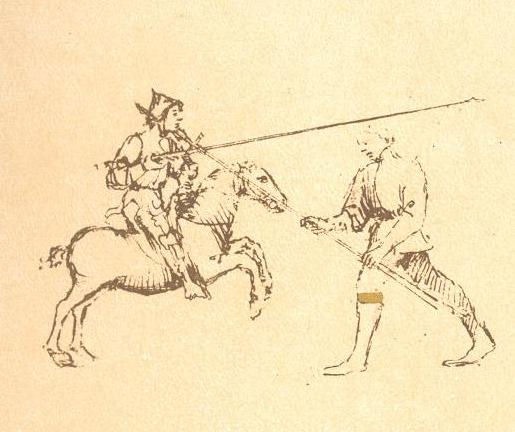Blue Spur Spear Fundamentals: High and Low Wards
A bevy of English longbowmen aside, nothing could make a mounted knight as nervous as a line of infantry with long spears. A spear from the ground can equal a sword from horseback in reach, and presents much more of a challenge to a knight than does a sword or axe, especially when planted against a cavalry charge. However, if you can't beat 'em, join 'em: the spear was a mounted weapon as well, used by early Greeks, mediaeval knights, and 19th century cavalry.
As with all our weapons, we teach you to use spears from the ground before moving to horseback. For your Blue Spur you will need to demonstrate Spear Fundamentals from the ground. The first item in the checklist is:
- Demonstrate proper position and movement in the high and low ward in the extended position.
For the purpose of these descriptions, we'll assume you are holding the spear with a right-hand lead... that is, the left hand is near the base of the shaft, and your right hand a quarter to a third of the way up, depending on its length. Since we usually train with staves without spearheads, I will refer interchangeably to 'spear' and 'staff'.
The High Ward
In the high ward the spear point is up just above the height of your head and pulled off to your right side so that all high targets are on the inside, or left, of your staff. It is important to make sure you are fully closing the outside line so that no high targets are available to the right of your staff. The height of the spearhead is equally important: if it is too low you must raise it to parry, which will cost you time.
Hold the staff at the base with a relaxed and comfortable arm. The left hand should 'float' about a hand's width in front of your left hip, rather than be tucked in to the body. This allows you space to lever the spear sharply to the left to close the inside line by snapping your trailing hand inward.
You can think of this guard as the equivalent of terza with the rapier, or porta di ferro stretta with the longsword.
The Low Ward
In the low ward the hands are above the head with the point down and to the right. Depending on the length of the spear and the purpose of the guard the point may either float free or be touching the ground. Both eyes look under the staff on the inside.
The right arm should be straight. As you transition from low to high make sure you allow the shaft to rotate in your right hand (gripping with your hand will cause your elbow to bend and ruin your guard). Take care to keep the left hand far enough back. If it is too far forward, an opponent can target the hand and drive the base of the shaft towards your head.
Practise the transition from high to low and back again. Your right arm essentially stays in place with a relaxed grip on the staff while the left moves the end of the spear. Also practise defending from each guard and returning to the same guard to cement the position in your muscle memory.
You can think of this position as similar to prima with the rapier, or finestra with the longsword.
If you are Duello TV subscriber I recommend viewing lessons 1 and 2 of the Quarterstaff section, which cover the High and Low wards.
Want more spear work? Join us at Carosella 2015 for Devon Boorman's Spear & Lance workshop, as well as three full days of mounted combat, mounted archery and knightly games!
The Flower of Battle
The Vancouver B Movie Factory's Flower of Battle that was filmed at Red Colt with members of our program is now available on YouTube. Thanks to Michael Molnar, Ben Davies, Chris Richardson, Kate Landels, Eleanor Landels and Isabel Landels, who donated their time and talents to this fun project!
The full half-hour 'making of' episode, with a bunch more footage is here.
